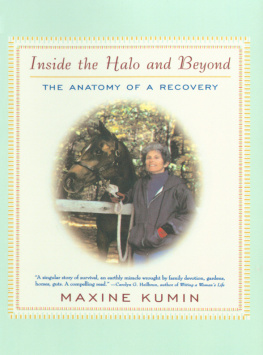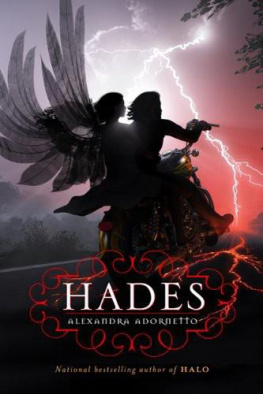Inside the Halo
and Beyond
Also by Maxine Kumin
POETRY
Selected Poems 19601990
Connecting the Dots
Looking for Luck
Nurture
The Long Approach
Our Ground Time Here Will Be Brief
The Retrieval System
House, Bridge, Fountain, Gate
Up Country
The Nightmare Factory
The Privilege
Halfway
NOVELS
Quit Monks or Die!
The Designated Heir
The Abduction
The Passions of Uxport
Through Dooms of Love
SHORT STORIES
Why Cant We Live Together Like Civilized Human Beings?
ESSAYS
In Deep: Country Essays
To Make a Prairie: Essays on Poets, Poetry, and Country Living
ESSAYS AND STORIES
Women, Animals, and Vegetables

For Kathy Waine
who saved my life
and
for Judith Kumin
who helped me reconstruct it
July 21, 1998
 A perfect midsummer day in Vermont, the world in full leaf, sunny but with a fair breeze. Ideal for the last driving clinic before the gala three-day carriage-driving show this coming weekend. About a dozen of us, including two pairscarriages drawn by matched horsesare warming up on a large grassy area enclosed by a fence on one long side, buildings on another. A stone wall at the top of the field divides it from the state road. Were going to practice driving figures for the dressage phase of the show. Just as ice skaters have certain patterns they must execute in competition, carriage drivers also must demonstrate patterns including circles, serpentines, changes of direction and pace, good square halts, and backing up in straight lines.
A perfect midsummer day in Vermont, the world in full leaf, sunny but with a fair breeze. Ideal for the last driving clinic before the gala three-day carriage-driving show this coming weekend. About a dozen of us, including two pairscarriages drawn by matched horsesare warming up on a large grassy area enclosed by a fence on one long side, buildings on another. A stone wall at the top of the field divides it from the state road. Were going to practice driving figures for the dressage phase of the show. Just as ice skaters have certain patterns they must execute in competition, carriage drivers also must demonstrate patterns including circles, serpentines, changes of direction and pace, good square halts, and backing up in straight lines.
There are two new horses here today; they look like young Arabians with their pretty little dished profiles. Its going to be a nuisance to integrate them into our already cohesive group. The owners put one in a stall and hitch the other to drive. The stabled horse whinnies frantically when his buddy leaves. Then he leaps up over the four-foot dutch door and races out onto the field, where were all intently moving on our own, concentrating on getting our horses limber and balanced before the formal session with our driving instructor begins.
Although theyve never met before, the loose horse makes a beeline for my horse Deuter, perhaps attracted by his bright red chestnut color, and runs into him head on. I feel Deuter jitter and suck back behind the bit. Is he going to rear and then plunge forward to escape?
Easy, Dude, I tell him. Eas-ay, eas-ay, words he knows but doesnt always honor.
Finally, one of the owners runs out with a lead shank and captures the little loose horse. Crisis past, Deuter seems to relax in my hands. He rounds over nicely on the bit, and comes across the diagonal at an extended trot, a little overeager but presumably none the worse for the encounter.
Talk about dj vu all over again, the instructor says as we come past her. That was quite a flashback he had. Some things they never forget. Shes a highly regarded woman in the horse world, not only as a trainer and driver but also for what I call horse charisma, her ability to read an animal from the way he is moving and responding.
I agree with her as we trot past. He almost lost it there but I think hes over it, I say, and we cross the field once more out of her line of sight. The very first time we hitched him at this same facility, he was run into by a bridleless horse still attached to his cart. (Taking the bridle off before detaching the horse from the carriage is a breach of etiquette serious enough to get the miscreant disbarred.) Luckily, Deuter was safely out of the shafts at the time, but he fled in terror from the assault and ran two miles up a steep dirt road before the groom on a coach-and-four that was coming down the hill jumped off and retrieved him.
For at least a year Deuter became restive whenever another rig came toward him, particularly if the carriage was drawn by a pair of horses, with the attendant extra rattle and banging sounds. Now, though, he feels like his old self. My navigator, who has been riding on the back step of the carriage, dismounts and joins a group of observers on the sidelines.
Then, as we come to the top of the field along the stone wall, an immense piggyback logging truck roars up behind us, its multiple chains making a considerable racket.
Without warning, Deuter shifts out of his soft floating trot into a gallop. It takes me about three seconds to realize what hes done; I keep thinking hell come back into my hands in another stride or two. We tear around one corner by the buildings and he bounces me out of my seat. I struggle to regain my balance and finally find the brake with my right foot, but even with all my weight on it, the mechanism is powerless to slow him down. There are all those carriages to steer around. I dont dare bail out. What if he runs into someone?
The carriage that Im driving is a four-wheel metal marathon vehicle with a wedge seat that is supposed to hold the driver, or whip, securely in place. Theres a stand on the rear for the navigator, or groom, who accompanies the driver during the marathon phase of a driving show; the whole rig weighs about 350 pounds.
For the accident itself I have total amnesia. I come back to consciousness facedown, arms and legs asprawl. My limbs are numb, I am only vaguely aware they are still attached to me. Kathy, an old carriage-driving buddy who happens to be an emergency room nurse, is kneeling beside me, keeping me absolutely immobile. It is she who saves my life.
I gasp, I cant breathe, and she comforts me. Yes, you can. Just keep taking little sips of air.
Before the helicopter comes, before it swoops down beside me, the menacing roar of its rotors rousing me momentarily, I fade in and out of consciousness. Troughs and swells of pain suck me down, then spit me out. They roll me over and over, a pebble caught in this ocean where time has no limits and agony is without beginning or end.

The helicopter lands on its tidy pad just outside the Trauma Center. I remember only fleeting moments of this experiencethe terrible jolts of my stretcher being loaded and unloaded, the unspeakable, all-over pain. Victor, my husband, tells me they worked on me in the Trauma Center for about five hours while he sat in the waiting room. The doctors came and went every half hour with further newsof my punctured lung, of multiple broken ribs, of internal bleeding, and bruised kidney and liver, and loss of neurological function. Oh my God, oh my God, was all he could say at each notification, this man who is seldom at a loss for words.
July 22
 Imagine a bird cage big enough for a large squawking parrot. Nothing fancy; no rococo bars with curlicues at the top, just a sturdy cage fashioned from titanium and graphite, but missing a few bars front and back. Imagine a human head inside the cage fastened by four titanium pins that dig into the skull. The pins are as sharp as ice picks. I wake up in this cage, disoriented, desperate, sicker than I have ever been. No feeling in my arms or legs, but a vague sense that my head is entrapped forever. No movement left or right, up or down. I am a stationary parrot inside my strict cage.
Imagine a bird cage big enough for a large squawking parrot. Nothing fancy; no rococo bars with curlicues at the top, just a sturdy cage fashioned from titanium and graphite, but missing a few bars front and back. Imagine a human head inside the cage fastened by four titanium pins that dig into the skull. The pins are as sharp as ice picks. I wake up in this cage, disoriented, desperate, sicker than I have ever been. No feeling in my arms or legs, but a vague sense that my head is entrapped forever. No movement left or right, up or down. I am a stationary parrot inside my strict cage.

Some orthopedic wag dubbed this form of axial traction a halo. First applied in 1959, it was attached to a rigid full-body cast and was used to immobilize paralyzed polio patients whose airways were in danger because they could not hold their heads upright. Later, its usage extended to postop patients with cervical spine injuries, tumor removals, and congenital spinal malformations. The early halos, weighing upwards of ten pounds, were made of metal, which was opaque to X ray and was not MRI or CT scan compatible. Modern halos are made of lightweight composites. The full-body cast has given way to an adjustable plastic vest and the metal uprights of the cage are made of anodized metals so that they dont seize during tightening. Knurled bars are designed to prevent slipping; the entire halo must remain structurally intact.
Next page











 A perfect midsummer day in Vermont, the world in full leaf, sunny but with a fair breeze. Ideal for the last driving clinic before the gala three-day carriage-driving show this coming weekend. About a dozen of us, including two pairscarriages drawn by matched horsesare warming up on a large grassy area enclosed by a fence on one long side, buildings on another. A stone wall at the top of the field divides it from the state road. Were going to practice driving figures for the dressage phase of the show. Just as ice skaters have certain patterns they must execute in competition, carriage drivers also must demonstrate patterns including circles, serpentines, changes of direction and pace, good square halts, and backing up in straight lines.
A perfect midsummer day in Vermont, the world in full leaf, sunny but with a fair breeze. Ideal for the last driving clinic before the gala three-day carriage-driving show this coming weekend. About a dozen of us, including two pairscarriages drawn by matched horsesare warming up on a large grassy area enclosed by a fence on one long side, buildings on another. A stone wall at the top of the field divides it from the state road. Were going to practice driving figures for the dressage phase of the show. Just as ice skaters have certain patterns they must execute in competition, carriage drivers also must demonstrate patterns including circles, serpentines, changes of direction and pace, good square halts, and backing up in straight lines.